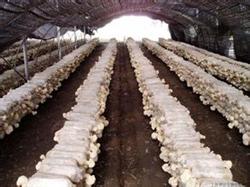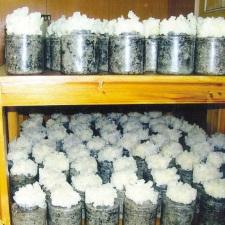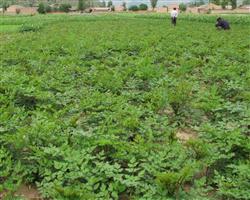How to grow hericium Erinaceus in plastic greenhouse?

How to grow hericium Erinaceus in plastic greenhouse? Please introduce that hericium Erinaceus is a kind of medium-and high-grade edible fungus with special flavor and high nutrition and health value. With the improvement of people's living standards, the sales market of fresh monkey head mushrooms is gradually expanding. Popularizing the cultivation of hericium Erinaceus can not only meet people's consumption needs, but also help mushroom farmers get rich. Now the technology is introduced as follows: first, the construction of plastic greenhouse chooses flat terrain, close to water source and clean environment to build shed. Greenhouse specifications: the east-west length is about 45 meters (determined according to the cultivation scale), the north-south width is 8 meters, the north wall height (including digging depth) is 2.8 meters, and the south wall height is 1. 6 meters. A partition wall is built every 15 meters between the north and the south. The wall is a brick structure, the north wall is a double-layer hollow wall to facilitate thermal insulation, and the south wall has two windows every 3 meters for ventilation. The shed is dug 50 cm below the ground, and the top surface of the shed is covered with non-dripping film for heat preservation. Qualified mushroom farmers can also use the winter warm vegetable greenhouse for hericium Erinaceus cultivation. 2. In the cultivation season, according to the temperature requirements of the growth and development of hericium Erinaceus, plastic greenhouse is used to cultivate hericium Erinaceus in Shandong Province. the cultivation bags should be made in the middle of October, and the mushroom will begin to produce in the middle and late November after about one month's cultivation, and the mushroom production will end in the first and middle of March of the following year. 3. Preparation of cultivation bag 1. Culture material preparation formula ①: cotton seed shell 90%, wheat bran 8%, gypsum 1%, calcium superphosphate 1%. Formula ②: cotton husk 58%, sawdust 30%, wheat bran 10%, gypsum 1%, calcium superphosphate 1%. Formula ③: cottonseed husk 50%, corncob powder 38%, wheat bran 10%, gypsum 1%, calcium superphosphate 1%. Mix the above ingredients well and adjust the water content to 65% according to the ratio of material to water: 1: 1. 2: 1: 1: 1.4 by adding water. 2. 15 cm × 32 cm ~ 34 cm × 0.04 cm polypropylene plastic bags are used for bagging. The weight of dry material in each bag is about 0.4 kg ~ 0.45 kg. Press the material moderately, and then tighten the mouth of the bag with a rope. 4. Sterilization 1. Atmospheric pressure sterilization put the culture bag in a sterilizer layer by layer, heat it to 100 ℃, keep it for 10 hours, simmer for 5 to 6 hours, then take out the bag and cool it for inoculation. 2. High-capacity high-pressure sterilizer for high-pressure sterilization. The bag is also placed in layers to maintain the pressure of 1. 2 kg / square centimeter for 2 hours, then cool naturally to 00:00, open the pot cover and remove the bag to cool. When sterilizing in a large-capacity sterilizer, if the pressure is raised to 1. 5 kg / square centimeter, it is easy to cause molten bag and bag expansion, which will affect the sterilization effect. 5. Inoculation and culture. when the bag is cooled to less than 30 ℃, it is transferred to the inoculation box, which is fumigated with potassium permanganate and formaldehyde, and inoculated in aseptic operation for 20 minutes. Inoculation is carried out from both ends of the bag, generally 25 bags per bottle of bacteria. After inoculation, the material bag can be moved directly into the greenhouse to culture bacteria. Before moving into the greenhouse, fully disinfect the greenhouse, open windows to lower the temperature in the greenhouse, spray the ground and walls with lime water, and then fumigate for 24 hours with formaldehyde or sulfur. If the hericium Erinaceus is cultivated in the winter warm vegetable greenhouse, the inoculated material bag can be cultured separately in the culture room until the mycelium is about 2 cm deep, and then moved into the greenhouse to continue the culture. The material bag is discharged as a wall, each row is stacked with 6 layers, the bottom is covered with a layer of brick, and the row spacing is 60 cm, so as to facilitate management. During the period of bacteria culture, ventilation management should be strengthened, grass curtain should be added to the roof to shade, and the temperature in the shed should not exceed 27 ℃. After about 30 days, when the mycelium is nearly full, pour the bag to check and remove the bag with heavy contamination of miscellaneous bacteria, and the bag with strong growth can carry out mushroom production management. 6. the mushroom production management will untie the ropes at both ends of the bacteria-filled bag, and gently pull the mouth of the bag back to improve the internal ventilation conditions of the bag. Increase the humidity in the shed to more than 85%, and keep the temperature in the shed at 10 ℃ ~ 20 ℃. After entering the late November, the sunshine warming intensity in the northern area is obviously weakened, the grass curtain can be properly removed to increase the sunshine temperature in the daytime, and the grass curtain can be covered at night to keep warm. If the light is strong and the temperature in the shed is on the high side, grass curtains can be added to cover the shade during the day. Sunny and warm weather, gently open the south window for moderate ventilation. Generally, budding begins after 7 ~ 10 days, and should be harvested in time when the spines in the fruiting body of hericium Erinaceus are about 0.5 cm ~ 1 cm. After harvest, the mushroom root should be eliminated and continue to be cultivated. In the severe winter season, if the heat preservation effect of the greenhouse is poor, the management of mushroom production can be suspended and managed again after the temperature picks up in early February. Generally, 2 ~ 3 tide mushrooms can be collected, and the biological efficiency can reach 100%. Due to the good heat preservation performance of the greenhouse and the small evaporation in the greenhouse in winter, the times of spraying water should be properly reduced in the management, and it is strictly forbidden to spray water to the mouth of the bag and the mushroom bud, so as not to cause the mushroom bud to rot. For the mushroom bags that have been out of 2 tide ~ 3 tide mushrooms, the method of covered soil border planting can be adopted, and its biological efficiency can generally exceed 120%. The method is as follows: dig a border 1.2 meters wide and 25 centimeters deep in the shed, remove the plastic bags, put three or four in a bunch of vertical beds, cover with fine loam about 2 centimeters thick, pour through water, and then keep the border moist for about 15 days. a tide of mushrooms can be produced, and the diameter of the mushroom body can reach more than 25 centimeters. When the thorn is up to 0.5 cm long, it can be harvested carefully, and the mushroom stalk with soil can be cut off with a knife and can be sold or processed. By using this method, the mushroom emergence period can be extended to the middle and late April. This method can also be used for bag cultivation of hericium Erinaceus without mushroom, and the effect of increasing yield is also very obvious. Click to get more cultivation techniques of hericium Erinaceus
- Prev

How to grow Tremella fuciformis in bottles?
How to grow Tremella fuciformis in bottles? Please give guidance to bottle Tremella production cycle is short, not limited by the season, less labor, quick income, is a good family sideline, bottle Tremella method can refer to the following: first, the preparation of culture materials 1. The formula of culture material: sawdust 50 kg, wheat bran or rice bran 15.
- Next

How to cultivate Angelica sinensis?
How to cultivate Angelica sinensis? Please introduce in detail the dried root of Angelica sinensis, also known as Qin Gui, which is a commonly used traditional Chinese medicine with the effects of tonifying blood, activating blood circulation, relieving pain and moistening intestines. Mainly produced in Gansu, Shaanxi, Yunnan, Sichuan and other provinces, cultivated in most areas of Shaanxi. (-) morphological characteristics should be attributed to many.
Related
- Fuxing push coffee new agricultural production and marketing class: lack of small-scale processing plants
- Jujube rice field leisure farm deep ploughing Yilan for five years to create a space for organic food and play
- Nongyu Farm-A trial of organic papaya for brave women with advanced technology
- Four points for attention in the prevention and control of diseases and insect pests of edible fungi
- How to add nutrient solution to Edible Fungi
- Is there any good way to control edible fungus mites?
- Open Inoculation Technology of Edible Fungi
- Is there any clever way to use fertilizer for edible fungus in winter?
- What agents are used to kill the pathogens of edible fungi in the mushroom shed?
- Rapid drying of Edible Fungi

